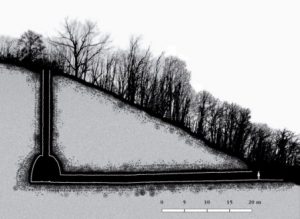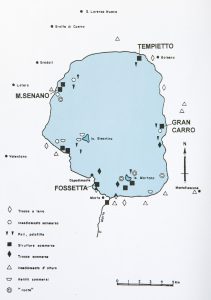THE FANUM VOLTUMNAE
According to the archeologists who have since about ten years made excavations in Orvieto, this Umbrean city was probably the place of the Fanum Voltumnae, the common sanctuary of the twelve Etruscan tribes, where every year the twelve lucumoni convened for their common deliberations and to perform the rituals in honor of their most important national deity, Voltumna.

The Fanum was thus the sacred navel (omphalos), or the religious and federal center of the entire Etruscan nation.
Orvieto was undoubtedly an important Etruscan city and it certainly must have had its own temple dedicated to the highest Etruscan deity. The same goes for other important cities in the Tirrenean area: Volterra, Volturnum (Capua), Felsina (Bologna), etcetera.
But concerning the federal sanctuary of the twelve Etrsucan cities there are many indications, traditions and monuments that support the idea that this was situated at the shores of the Bolsena Lake. The goal of this article is to synthesize the pieces of evidence about this topic, that until now have not been taken into consideration but are very relevant nevertheless.
FANUM
In the Dictionary of the Latin Language (B.Calonghi), under the entry “fanum”, the following meanings can be found: “ consecrated place, dedicated to a deity; sacred enclosure, sanctuary, temple”.

There is a considerable difference between the latin words “templum” and “fanum”. The first usually refers to an architectural temple, a building; the second has a broader meaning, while it refers to a particular sacred place, a more or less extended natural site with sacred characteristics. There is usually a connection between a “fanum” and a special natural place: a lake, a forest, a spring or a mountain: Fanum Feroniae (the sacred wood of Feronia, under the Monte Soratte), Fanum Dianae (the sacred wood of Diana, on the Monte Albano), Fanum Fortunae (in Fano, under the Monte Giove). These places were also indicated with the term “lucus” (wood). They were often dedicated to female deities, in the vicinity of famous sacred mountains, outside the dwelling places, on sites that were already frequently visisted in pre-etruscan times and where people later, in historical times, made sanctuaries and temples. The meaning of the word “fanum” originates from this ancient vision of a territory, in which to each sacred place was given a specific identity, a special Genius Locii, which was the source of the sacer.
In the research about the Fanum Voltumnae it is thus essential to look for a territory that is related to the veneration of Voltumna, rather than for a single temple. Considering the fact that in those times this was a national deity, it seems logical that many Etruscan cities harboured temples dedicated to Voltumna.
VOLTUMNA
In the Dictionary of the Latin Language (Calonghi), at the entry “Voltumna”, is written: “Voltumna, ae, feminine, protective goddess of the confederation of the twelve Etruscan states. Near her temple the general assembly was held, Livio 4, 23, 5 and others”.
So Voltumna was a goddess, as is also argued by major linguists and historians, and not a “bisexual” god, as argued by M. Pallottino and his “school” who confused the Etruscan dyad (Veltune, the god and Voltumna, the goddess) with an androgynous deity that never existed. According to authoritative historians and philologists, the name of the goddess was during the centuries transformed into Vortumna and Fortuna; the etymological meaning however remained the same: volt, vort, fort refering to“volgere, vertere, girare”: the wheel of fortune was indeed the most important symbol of the goddess. A famous tradition tells that the temple of the goddess Fortuna, who was called Nortia by the Etruscans, was situated in Volsinii. There are still several images and reproductions from this temple: (1): the temple is depicted at the northern entrance of Bolsena, in front of the Porta Fiorentina. According to the tradition (as described f.e. in Livius, Tacitus, Plinius e.a.) the Etruscan temple of Nortia, at Volsinii (= Bolsena), was the place where the “chiodo fatale”, was kept, a long ritual nail that recorded the passing of the years. So the “wheel of fortune” was also the wheel of time and of fate.
THE “AIOLE”, PROTO-HISTORIC MOUNDS (3)
The so-called “aiole” of Bolsena are the most striking proof of the existence of special constructions used for sacralizing the lake and its shores, long before the Etruscan arrived here. The “aiole” were discoverd by Alessandro Fioravanti, geologist, archeologist, engineer, who in the fifties invented the first methods for underwater archeological research.

He found four enormous mounds, that were erected at the four shores of the lake, before – in the Xth centrury b.C.- the level of the water rose about eight meters, thus covering these constructions.

All the four mounds were erected above wells of thermal water, situated on the ancient shores, at the edge of the extended water surface of the lake. The function of these four impressive sacred monuments (the largest, the Gran Carro, is 80 m long, 60 m wide, and 5 m high) was to mark the territory according to an ancient conception of the cult of the waters. The four tumuli bear witness to a foundation rite of pre-etruscan times. Later the lake was considered sacred by the Etruscans and also in the Christian Middle Ages, when it was called “the lake of Santa Cristina”.
SANTA CRISTINA
Nowadays it is commonly accepted that the Christian tradition is superimposed on places that were formerly characterized by “pagan traditions”.
Santa Cristina is the Christian patroness of places of the water: lakes (Bolsena, Trasimeno, Orta etc..), rivers (Arno, Albegna, Po etc..), the sea (Palermo, Corsica, Spagna …) and other places of the water. As is the case with many other Christian saints her veneration replaced that of an earlier deity. In Bolsena, the veneration of this sacred martyr replaced that of Voltumna (or Fortuna, or Nortia …), the goddess of fortune, of abundance (whose symbol is the cornucopia) and of the fertilizing waters.
THE PILGRIMAGE TO THE FANUM AND THE VIA FRANCIGENA
Still today the pilgrimage along the via Francigena is one of the major Christian pilgrimages across Europe. According to the most authoritative scholars of History of Religions, making a pilgrimage can be seen as one of the most ancient forms of religious practice. In nearly all cases the important pilgrimages have prehistorical origins.
The pilgrimage of the via Francigena passes through San Lorenzo Nuovo (the place of a temple of the Etruscan goddess Turan), under the monte

Landro (where recently an important Etruscan temple was discoverd), to continue through Bolsena (the place of the Duomo di S. Cristina and several Etruscan temples), and the nearby Etruscan temple of Turona, to join Montefiascone (with a temple on the place of the Palazzo dei Papi). From there the road of the pilgrimage goes to Rome.
Inside the crater of the Bolsena Lake the via Francigena passes along a series of Etruscan temples, next to Christian churches, destroyed or still consecrated. The Etruscan pilgrimage to the Fanum di Volsinii is documented in the so-called “Rescritto di Spello”(4) (IV sec. d.C.), signed by the Roman emperor Costantine the Great. The pilgrimage to the Fanum has probably been practiced during many centuries, which explains why it was so deeply rooted in the area around the lake, so that later on it became necessary for the Christian church to transform it into a Christian pilgrimage. By making a detailed study of the route of the Francigena, it is possible to establish with precision the places of the earlier Etruscan pilgrimage to the Fanum.
TEMPLES IN THE AREA OF BOLSENA
Each of the four shores of the lake harbours remains or memories of numerous Etruscan temples, from Turona to Bisenzio, from Bolsena to San Lorenzo Nuovo, and from Montefiascone to Marta. The same goes for the necropolis that, for the major part, are still laying under the earth, hardly appreciated or taken care of. There is an immense cultural heritage here, usually well known by the local people, but nowadays more and more abandoned and destroyed. Recently dr. Angelo Timperi, a former inspector and archeologist of the Soprintendenza for southern Etruria, who worked for 30 years in the Bolsena area, published the book “Il Fanum Voltumnae a Bolsena” (Viterbo 2010), in which he establishes the presence of an important Etruscan temple of the archaic period, of which the remains are laying in the fields near Poggio Moscini. Dr. Timperi also indicates other “forgotten” remains of the Etruscan Volsinii (= Bolsena).
Furthermore, in the spring of 2011 an Etruscan temple of the archaic period was discovered on the summit of the Monte Landro, between Bolsena and San Lorenzo Nuovo. The surface of this sanctuary was more than 100 square metres, in the midst of a still more extended sacred enclosure. Many precious remains are already found at the surface of this place, but the excavations have been unexpectedly interrupted and postponed (?!).
The temples and the “rudera templi” (temple remains) are mainly found on the Northern side of the lake, which is also visible thank to the rich medieval topography and the names of the places that are still conserved. The erudite Andrea Adami, in his “Storia di Volseno” (1737, Biblioteca di Bolsena), indicates the presence of a temple next to the Dome of S. Cristina (Poggio Pesce), dedicated to Apollo. The water bassin, that nowadays can be found on the sidewalk at the crossroads between the Piazza of Bolsena and the lake, probably comes from the same temple.
THE CLASSICAL SOURCES
The controversy about the location of the Etruscan Volsinii, that according to the tradition was the place of the Fanum of the 12 cities, circles around the thesis, created by Italian archeologists, that Bolsena would have been founded in the III century b.C. (Volsinii Novi or New Volsinii), after the Roman conquest of Orvieto (Volsinii Veteres or Old Volsinii), which would have been the place of the Fanum Voltumnae. The French archeologist Raymond Bloch, who performed extended excavations in Bolsena, discovered however a city wall of the archaic age (V century. b.C.). But after the rumour of this discovery had been silenced, Italian archeologists ‘reformulated” the datation: the wall would have been from the end of the third century, and thus built after the Roman occupation. This thesis is weakened by the evidence that the walls of other Etruscan cities have been erected in the period of the Roman Republic (V century b.C.), for obvious defensive reasons: after the Etruscan kings were chased away from Rome, all Etruria would come under attack. Veio was the first city that fell (beginning of the IV century), while Volsinii and Vulci were the last (end of the III century).
The descriptions of the city of Volsinii, as made by pseudo-Aristotele and Zonara (2), establish however several points:
a) Volsinii had a mighty city wall, that is later found in Bolsena and not in Orvieto.
b) In the midst of the city of Volsinii was a steep hill, and also this is present in Bolsena and not in Orvieto.
c) There was a rich presence of water in Volsinii. Apart from the lake, the city of Bolsena has many wells; Orvieto is situated between dry clay hills.
NOTES
1) The images of the temple of Nortia are published in “Bolsena Sparita”, by A. Fioravanti, Bolsena 1991. The text is available in the Biblioteca Comunale di Bolsena.
2) See J. Zonara, Epit. Histor, VIII, 7; Pseudo-Aristotele, Vol. IV De Mirab. Auscult.
3) This argument is described in number four of the “Quaderni” of the Association Tages in Pitigliano.
4) The Rescritto di Spello consists of an inscription on stone with which emperor Constantine authorized the Etruscans of Spello to celebrate the annual festivities in their own sanctuary (probably the Fonti del Clitumno). The Umbrians of Spello had asked the emperor for permission to celebrate this important festivity on their own territory in order to avoid the burden of the heavy pilgrimage across mountains and valleys to the Fanum di Volsinii.
(versione italiana)
